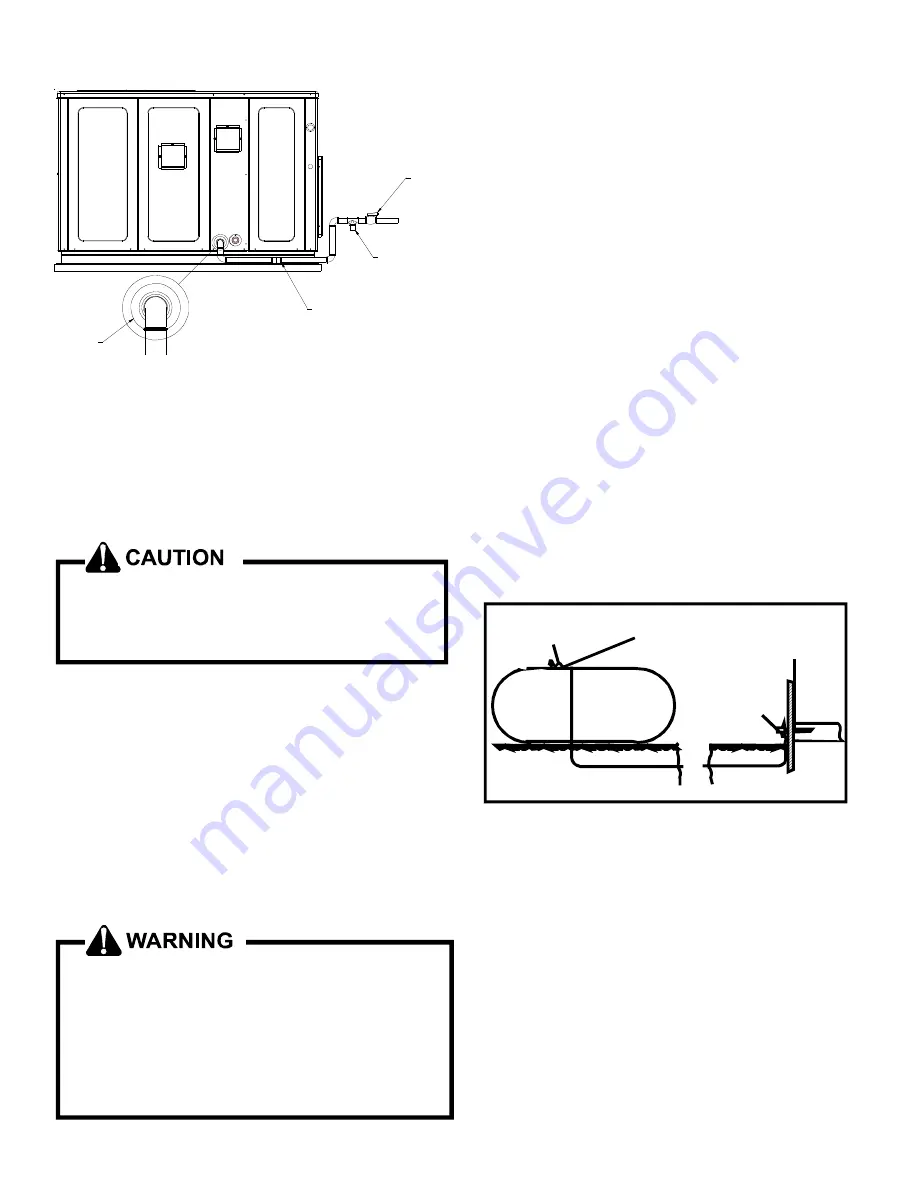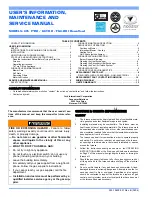
PRODUCT DESIGN
16
DRIP LEG
MANUAL
SHUT-OFF
VALVE
GROUND JOINT UNION
(INSTALLED AHEAD OF GAS VALVE)
GROMMET
NOTE:
The unit gas supply entrance is factory sealed with
plugs. Keep plugs in place until gas supply is ready to be
installed. Once ready, replace the plugs with the supplied
grommets and install gas supply line.
CHECKING THE GAS PIPING
To avoid the possibility of property damage, personal
injury or fire, the following instructions must be
performed regarding gas connections and pressure
testing.
The unit and its gas connections must be leak tested before
placing in operation. Because of the danger of explosion or
fire, never use a match or open flame to test for leaks. Never
exceed specified pressure for testing. Higher pressure may
damage the gas valve and cause overfiring which may result in
heat exchanger failure.
This unit must be isolated from the gas supply system by
closing its individual manual shutoff valve during any pressure
testing of the gas supply piping system at test pressures equal
to or less than 1/2 psig (3.48 kPa).
TANKS AND PIPING - PROPANE UNITS
PERSONAL INJURY HAZARD
Iron Oxide (rust) can reduce the level of odorant in
propane gas. A gas detecting device is the only
reliable method to detect a propane gas leak. Contact
your local propane supplier about installing a gas
detecting warning device to alert you in the event
that a gas leak should develop. Failure to detect a
propane gas leak could result in an explosion or fire
which could cause serious personal injury or death.
All propane gas equipment must conform to the safety stan-
dards of the National Board of Fire Underwriters (See NBFU
Manual 58) or Natural Standards of Canada B149.2, Installa-
tion Code for Propane Gas Burning Appliances and Equipment.
For satisfactory operation, propane gas pressure must be 10
inch W.C. at the unit manifold with all gas appliances in opera-
tion. Maintaining proper gas pressure depends on three main
factors.
1. Vaporization rate, which depends on (a) temperature of the
liquid, and (b) "wetted surface" area of the container or
containers.
2. Proper pressure regulation. (Two-stage regulation is rec-
ommended from the standpoint of both cost and efficiency.)
3. Pressure drop in lines between regulators, and between
second stage regulator and the appliance. Pipe size re-
quired will depend on length of pipe run and total load of all
appliances.
Complete information regarding tank sizing for vaporization,
recommended regulator settings, and pipe sizing is available
from most regulator manufacturers and propane gas suppliers.
Propane is an excellent solvent, and special pipe dope must
be used when assembling piping for this gas as it will quickly
dissolve white lead or most standard commercial compounds.
Shellac base compounds resistant to the actions of liquefied
petroleum gases such as Gasolac®, Stalactic®, Clyde's or
John Crane are satisfactory.
TYPICAL PROPANE PIPING
200 PSIG
Maximum
5 to 15 PSIG
(20 PSIG Max.)
Continuous
11" W.C.
Second Stage
Regulator
First Stage
Regulator

![Preview for 2 page of Goodman [A/G]PG Service Instructions Manual](http://thumbs.mh-extra.com/thumbs/goodman/a-g-pg/a-g-pg_service-instructions-manual_2243406-02.webp)
![Preview for 3 page of Goodman [A/G]PG Service Instructions Manual](http://thumbs.mh-extra.com/thumbs/goodman/a-g-pg/a-g-pg_service-instructions-manual_2243406-03.webp)
![Preview for 4 page of Goodman [A/G]PG Service Instructions Manual](http://thumbs.mh-extra.com/thumbs/goodman/a-g-pg/a-g-pg_service-instructions-manual_2243406-04.webp)
![Preview for 5 page of Goodman [A/G]PG Service Instructions Manual](http://thumbs.mh-extra.com/thumbs/goodman/a-g-pg/a-g-pg_service-instructions-manual_2243406-05.webp)
![Preview for 6 page of Goodman [A/G]PG Service Instructions Manual](http://thumbs.mh-extra.com/thumbs/goodman/a-g-pg/a-g-pg_service-instructions-manual_2243406-06.webp)
![Preview for 7 page of Goodman [A/G]PG Service Instructions Manual](http://thumbs.mh-extra.com/thumbs/goodman/a-g-pg/a-g-pg_service-instructions-manual_2243406-07.webp)
![Preview for 8 page of Goodman [A/G]PG Service Instructions Manual](http://thumbs.mh-extra.com/thumbs/goodman/a-g-pg/a-g-pg_service-instructions-manual_2243406-08.webp)
![Preview for 9 page of Goodman [A/G]PG Service Instructions Manual](http://thumbs.mh-extra.com/thumbs/goodman/a-g-pg/a-g-pg_service-instructions-manual_2243406-09.webp)
![Preview for 10 page of Goodman [A/G]PG Service Instructions Manual](http://thumbs.mh-extra.com/thumbs/goodman/a-g-pg/a-g-pg_service-instructions-manual_2243406-10.webp)
![Preview for 11 page of Goodman [A/G]PG Service Instructions Manual](http://thumbs.mh-extra.com/thumbs/goodman/a-g-pg/a-g-pg_service-instructions-manual_2243406-11.webp)
![Preview for 12 page of Goodman [A/G]PG Service Instructions Manual](http://thumbs.mh-extra.com/thumbs/goodman/a-g-pg/a-g-pg_service-instructions-manual_2243406-12.webp)
![Preview for 13 page of Goodman [A/G]PG Service Instructions Manual](http://thumbs.mh-extra.com/thumbs/goodman/a-g-pg/a-g-pg_service-instructions-manual_2243406-13.webp)
![Preview for 14 page of Goodman [A/G]PG Service Instructions Manual](http://thumbs.mh-extra.com/thumbs/goodman/a-g-pg/a-g-pg_service-instructions-manual_2243406-14.webp)
![Preview for 15 page of Goodman [A/G]PG Service Instructions Manual](http://thumbs.mh-extra.com/thumbs/goodman/a-g-pg/a-g-pg_service-instructions-manual_2243406-15.webp)
![Preview for 16 page of Goodman [A/G]PG Service Instructions Manual](http://thumbs.mh-extra.com/thumbs/goodman/a-g-pg/a-g-pg_service-instructions-manual_2243406-16.webp)
![Preview for 17 page of Goodman [A/G]PG Service Instructions Manual](http://thumbs.mh-extra.com/thumbs/goodman/a-g-pg/a-g-pg_service-instructions-manual_2243406-17.webp)
![Preview for 18 page of Goodman [A/G]PG Service Instructions Manual](http://thumbs.mh-extra.com/thumbs/goodman/a-g-pg/a-g-pg_service-instructions-manual_2243406-18.webp)
![Preview for 19 page of Goodman [A/G]PG Service Instructions Manual](http://thumbs.mh-extra.com/thumbs/goodman/a-g-pg/a-g-pg_service-instructions-manual_2243406-19.webp)
![Preview for 20 page of Goodman [A/G]PG Service Instructions Manual](http://thumbs.mh-extra.com/thumbs/goodman/a-g-pg/a-g-pg_service-instructions-manual_2243406-20.webp)
![Preview for 21 page of Goodman [A/G]PG Service Instructions Manual](http://thumbs.mh-extra.com/thumbs/goodman/a-g-pg/a-g-pg_service-instructions-manual_2243406-21.webp)
![Preview for 22 page of Goodman [A/G]PG Service Instructions Manual](http://thumbs.mh-extra.com/thumbs/goodman/a-g-pg/a-g-pg_service-instructions-manual_2243406-22.webp)
![Preview for 23 page of Goodman [A/G]PG Service Instructions Manual](http://thumbs.mh-extra.com/thumbs/goodman/a-g-pg/a-g-pg_service-instructions-manual_2243406-23.webp)
![Preview for 24 page of Goodman [A/G]PG Service Instructions Manual](http://thumbs.mh-extra.com/thumbs/goodman/a-g-pg/a-g-pg_service-instructions-manual_2243406-24.webp)
![Preview for 25 page of Goodman [A/G]PG Service Instructions Manual](http://thumbs.mh-extra.com/thumbs/goodman/a-g-pg/a-g-pg_service-instructions-manual_2243406-25.webp)
![Preview for 26 page of Goodman [A/G]PG Service Instructions Manual](http://thumbs.mh-extra.com/thumbs/goodman/a-g-pg/a-g-pg_service-instructions-manual_2243406-26.webp)
![Preview for 27 page of Goodman [A/G]PG Service Instructions Manual](http://thumbs.mh-extra.com/thumbs/goodman/a-g-pg/a-g-pg_service-instructions-manual_2243406-27.webp)
![Preview for 28 page of Goodman [A/G]PG Service Instructions Manual](http://thumbs.mh-extra.com/thumbs/goodman/a-g-pg/a-g-pg_service-instructions-manual_2243406-28.webp)
![Preview for 29 page of Goodman [A/G]PG Service Instructions Manual](http://thumbs.mh-extra.com/thumbs/goodman/a-g-pg/a-g-pg_service-instructions-manual_2243406-29.webp)
![Preview for 30 page of Goodman [A/G]PG Service Instructions Manual](http://thumbs.mh-extra.com/thumbs/goodman/a-g-pg/a-g-pg_service-instructions-manual_2243406-30.webp)
![Preview for 31 page of Goodman [A/G]PG Service Instructions Manual](http://thumbs.mh-extra.com/thumbs/goodman/a-g-pg/a-g-pg_service-instructions-manual_2243406-31.webp)

















